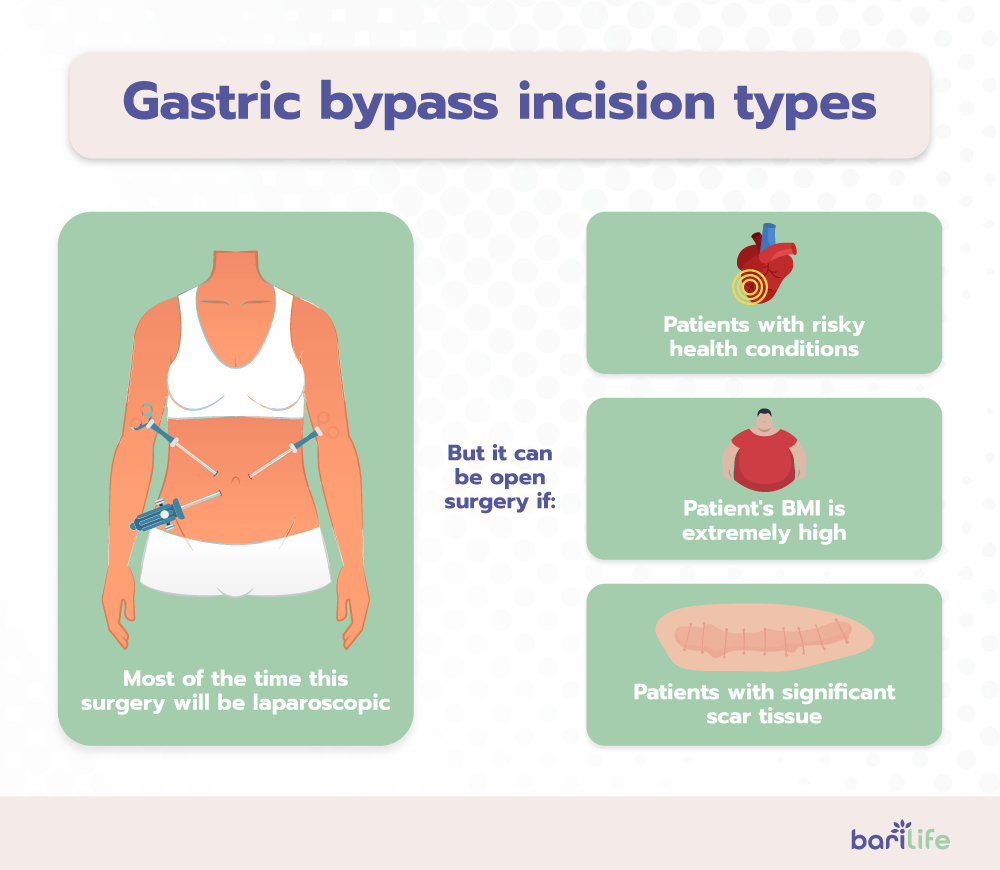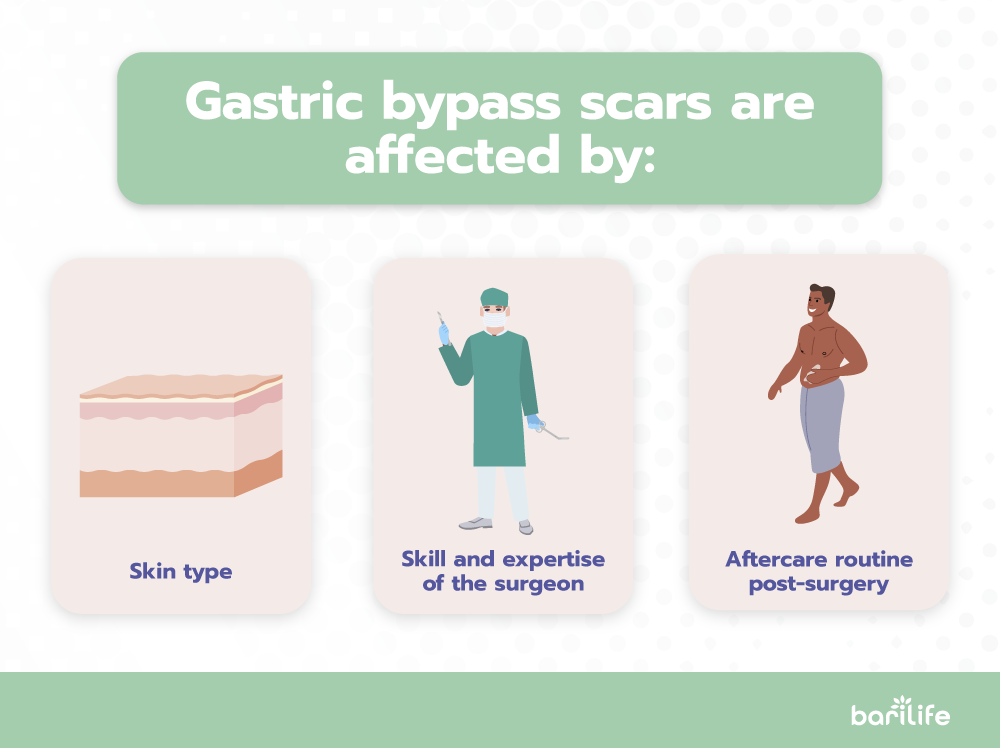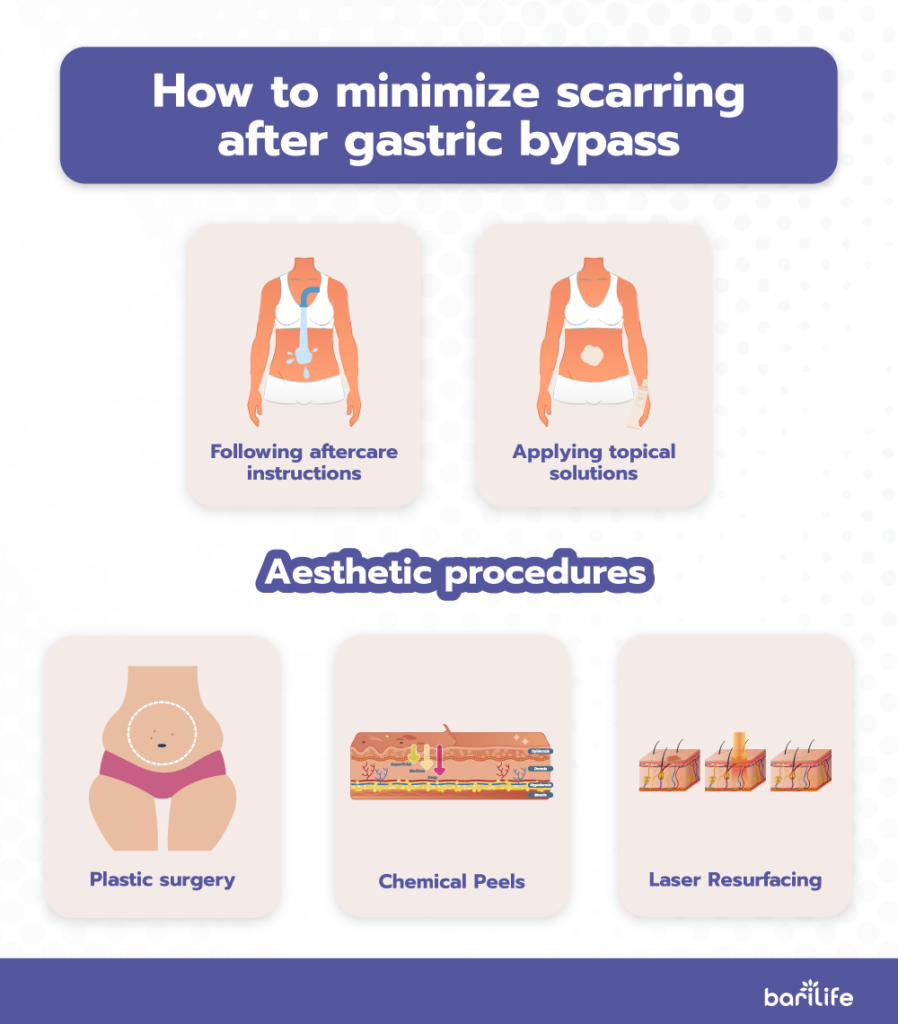Bariatric surgery is a treatment that alters your digestive system to promote weight loss. These surgeries are used when traditional diet and exercise have been unsuccessful, or when you have serious health complications related to your weight such as diabetes and hypertension.
The decision to have bariatric surgery is a big one, so it’s important that you’re informed about all aspects of the surgery and healing process. If incisions are something you are concerned about, continue reading to learn about gastric bypass incisions.
What is gastric bypass?
Gastric bypass, also known as the Roux-en-Y gastric bypass, is one of several bariatric surgeries used to alter the digestion of food in order to promote weight loss. Gastric bypass is considered the gold standard of bariatric surgery. It is the most commonly performed and most effective weight loss procedure.
The procedure changes the structure and function of the small intestine and the stomach. Your surgeon creates a small pouch from the stomach and connects the newly created pouch directly to the small intestine. When you eat, the food enters the new stomach pouch and travels to the lower part of the intestine, which bypasses the lower stomach and upper part of the intestine.
Not only is the amount of food that can be eaten decreased, hormones that promote abnormal blood sugar control are also affected. This often improves blood sugar and allows patients to lower the dose or eliminate their diabetes medications soon after surgery. The surgery also helps diminish appetite and increase satiety or fullness.
Gastric bypass incision types
The Roux-en-Y gastric bypass surgery can be performed laparoscopically or as an “open” procedure, also referred to as a laparotomy. The method you and your surgeon decide on will determine the type of incision or incisions you have.
The laparoscopic method is used more often than the open surgery, however certain conditions and patient characteristics require the surgery to be open for patient safety.
Open surgery may be needed if:
- Patient BMI is extremely high, or the patient has excessive abdominal fat that prevents the surgeon from accessing or seeing the entire surgical field
- Patients with significant scar tissue (possibly from another abdominal surgery) that disrupts access or view of the surgical field
- Patients with health conditions that increase risk of laparoscopic gastric bypass surgery
The laparoscopic method involves using a tiny camera, called a laparoscope. This camera is placed in your abdomen and allows the surgeon to see inside your belly. During the laparoscopic gastric bypass surgery, four to six small (¼ to ½ inch) incisions are made on the abdomen. Laparoscopic surgery allows for a much quicker recovery and reduced risk of complications.
The “open” method of performing gastric bypass is much more invasive. The surgeon makes a large cut, up to 10 inches to open the abdomen. The incision runs from the chest to the belly button.

Wound care
After surgery, you will spend 1-3 days in the hospital. It’s important to understand what you can and can’t do after gastric bypass. When you are discharged, you will receive specific instructions on how to care for your incision sites. It is critical to carefully follow these instructions to prevent infection and reduce the visibility of scarring.
Your provider may tell you to change your wound dressings daily. Be sure to change them if they get dirty or wet.
You may notice bruising surrounding the incisions. This is a normal part of the healing process and will go away on its own. It is also normal for the skin around the incisions to be red.
You should avoid wearing tight clothing that rubs against your incisions while they heal and keep your dressings clean and dry.
If you have stitches or staples, your surgeon will remove them about 7 to 10 days after surgery. Some stitches may dissolve on their own. Your surgeon will tell you if you have them.
Do not shower until after your follow-up appointment with your provider unless you are given other instructions.
When you are permitted to shower, do not scrub your incision or let the water beat down on it. Avoid soaking in a bathtub, swimming pool, or hot tub until you are cleared by your provider.
How long does it take for incisions to heal?
If aftercare instructions are followed correctly, most laparoscopic incisions heal in 2-3 weeks. If a laparotomy (open) is performed, the incisions may take longer to heal, up to 6 weeks.
Gastric bypass scars
Your scars will largely depend on the type of surgery you have, but scarring is also affected by other factors.
- Skin type – scars develop differently and vary from person to person. Ethnicity and skin tone can affect this. Scars are typically more visible on individuals with darker types of skin.
- Skill and expertise of the surgeon – although rare, sometimes surgery performed by a surgeon who is less skilled will cause increased scarring.
- Aftercare routine post-surgery – patients are provided aftercare instructions upon discharge. These instructions include how to care for their healing incisions. Following these instructions carefully can prevent an infection which can worsen scarring. If an infection does occur, it may be necessary to perform an “open” procedure to correct the situation which would likely result in more significant scarring.

Scars from laparoscopic surgery
Scars from laparoscopic gastric bypass surgery are usually between ½ to 1 inch long. Most of the time, 4-6 incisions are made in the abdomen. In most cases, one incision is made to insert a laparoscope with a tiny camera and the other incisions are used so surgeons can access the abdomen with the instruments used to perform the procedure.
Surgeons often use the belly button for the incision for the laparoscopic camera, so there are usually no visible scars. In approximately 90% of patients, the remaining 3-5 incisions will leave tiny scars that will almost be invisible after a year or two.
Scars from open gastric bypass
The open gastric bypass surgery leaves a much larger and more noticeable scar. The scar from this procedure may range from 8-10 inches and runs from the chest to the belly button. Incisions from open surgery have a higher risk of infection, which can significantly increase the severity of scarring.
How to minimize scarring
- Following aftercare instructions for recovery is the most important thing you can do to prevent infection and promote optimal wound healing.
- Applying topical solutions and creams to scars can lessen the appearance. Products like cocoa butter, vitamin E, silicone gel, and other over-the-counter products like Bio Oil and Mederma can often help heal scars.
- Plastic surgery can sometimes be used to change the appearance of a scar and make it less noticeable.
- Aesthetic procedures and treatments may also reduce the appearance of scars, including:
- Microdermabrasion
- Microneedling
- Laser Resurfacing
- Chemical Peels

Summary
There are many things you should consider when making the decision to undergo bariatric surgery. One of the things you may be concerned about is scarring. With any surgery, there will be some scarring. The level of scarring will depend largely on the type of gastric bypass surgery you have, either laparoscopic or open, and other individual factors.
Laparoscopic gastric bypass surgery will result in smaller (½ – 1 inch) and less noticeable scars. A laparotomy (open) surgery will result in larger (8 – 10 inch) and possibly more noticeable scars. It’s important to follow all aftercare instructions carefully to prevent infection which can worsen scarring and cause other complications.




What are your tips and tricks to post-bariatric success?